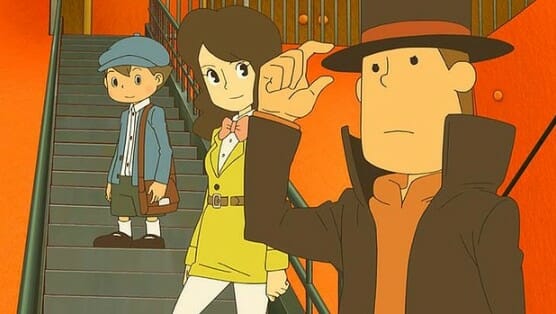Professor Layton and the Azran Legacy (3DS)

If you’re familiar with the Professor Layton games, released annually for Nintendo handhelds since 2007, there will be little in the series’ sixth title, Professor Layton and the Azran Legacy, to surprise you. Hershel Layton and his assistant Luke tear around a puzzle-obsessed near-Earth with a cast of supporting characters, engaging the locals with their favorite pastimes, which are puzzles, and resolving a nested cascade of mysteries, by solving puzzles, all while collecting hidden trinkets and playing minigames to unlock hidden game content, which are puzzles.
For the sub-Games Magazine brainteaser set like myself, these games are a godsend; the puzzles are traditionally well-constructed and balanced, and luxurious visuals and charming dialogue are draped over the whole affair. I tend to play these titles without allowing myself to rely on the in-game hint system, forcing my brain to extrude an answer, no matter how hard I slap my forehead at it, but the additional available assistance balances the series to accommodate brainy pre-tweens and casual players alike. Happily, all the games are like this, more or less; if all the above sounds pleasurable to you, I’d find it hard to recommend any specific title over another.
I might also, on the other hand, find it hard to remember which title I last played; regard the series from a few hundred yards and you could reasonably mistake any one Layton for another. (The Last Specter might be an exception, as it also included a 100-hour RPG, London Life, co-developed with Mother 3 developers Brownie Brown.) Frankly, I don’t think this is necessarily a flaw; this isn’t the sort of criticism you could reasonably level at, say, Friday the 13th Part VI. No, I mean it! Layton’s puzzler gameplay serves similar single-purpose utility as horror movies do jump scares, and the quality of the template is high enough to make the particulars of each game stand out on their own, once you are subsumed within them. Final Fantasy may take pains to make each entry stand out from one another, but I doubt we’ll see a Layton game as reviled for its unique decisions as was poor Final Fantasy VIII. And let’s be real: Gamestop’s shelves aren’t exactly packed with puzzle games like video stores were slasher films. You want puzzles, you go to where the puzzles are.
There is one key difference between the two, though: Layton’s narratives, unlike Voorhees’, constitute a single timeline. Excepting the full-length Layton movie, Professor Layton and the Eternal Diva, and the underheralded iOS sequel, Layton Brothers: Mystery Room, the Layton titles consist of a trilogy and a prequel trilogy (the latter of which is capped off by the game in question, Azran Legacy). In this way, Layton is a bit like Star Wars: It must live up to the expectations set by its forebears while innovating on its own script, all while planting its final episode directly in the middle of its own overarching narrative.
So these, then, are Azran Legacy’s problems: How to outdo the grandeur of each other game, in a production-value-minded series, and serve as a true sendoff to its protagonist? How to deliver a satisfying narrative climax which both resolves any stray loose ends, and also enriches the stories of games we’ve already played?
With grandeur, the game responds, breaking from the Layton formula by having you properly globetrot: In Azran Legacy, you zip all over the world, attempting to pull together the enigma which simmered just beneath Last Specter and Miracle Mask. And this, frankly, is my biggest bone to pick with the game: When Layton ventures out of London and barges his way into foreign cultures, in search of plot macguffins and more matchstick puzzles to solve, he does so not as a modern, professional archeologist, but as a plundering, destructive colonialist, with no compunctions about ruining local ecosystems and traditions for his own gain. I certainly don’t think the game intended to portray his actions in this way, but Indiana Jones Layton is not; there are five games’ full of him exhibiting kind and conscientious behavior, often in service of mentoring his child assistant. It is, therefore, disconcerting at best to see him forcing open holy sites at the protests of locals and smashing priceless stone tablets for hint coins, especially when archaeology itself underwent the process of reforming these habits throughout the 20th century. (The apotheosis of this behavior happens when he has his co-assistant Emmy block up a natural waterfall so nobody has to get their head wet walking underneath. USE A BIG FROND, DUDE!)
For a series which has put so much care into its dialog and character work, this misstep, which would be minor in any number of videogame series, is glaring—and some of the late-game plot work is absolutely groanworthy, a disappointment which had me fondly recalling the tight murder-mystery narrative of the first game, and how the plot’s revelations seemed to open before me in a thrilling rhythm.
-

-

-

-

-

-

-

-

-

-

-

-

-

-

-

-

-

-

-

-

-

-

-

-

-

-

-

-

-

-

-

-

-

-

-

-

-

-

-

-









































